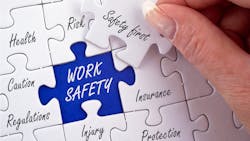5 Ways to Focus on Workplace Safety for National Safety Month
Download this article in PDF format.
Every year, the National Safety Council (NSC) dedicates an entire month to raising awareness of and reducing the leading causes of unintentional injury and death at work, on the road, and in homes and communities. A nonprofit organization dedicated to safety, health and environmental issues, the NSC started National Safety Month in 1912 and it’s celebrated every June.
For 2023, the NSC wants everyone to “Stay Safe at Work and Home” and is focusing on accidents or preventable injuries, which it says are the fourth leading cause of deaths in the U.S. Each week in June the NSC will focus its attention on a specific safety category, including emergency preparedness (for week one); slips, trips and falls (two); heat-related illness (three); and hazard recognition (four).
Procurement and supply chain professionals are well positioned to help keep their companies and workplaces safe. In “7 Ways Procurement Teams Can Impact Workplace Safety All Year Long,” for example, OMNIA Partners and Lawson Products say National Safety Month is a great time for organizations to raise awareness of the importance of safety in the workplace and their communities.
“According to the National Safety Council, a worker in the U.S. is injured on the job every seven seconds,” the company points out. “Of course, providing safe environments for workers and the public is all of our jobs all year long, but procurement teams can significantly influence safety-related issues and initiatives.”
5 Safety Steps to Take Now
Here are five ways that procurement teams and supply chain managers can reduce workplace accidents during National Safety Month and all year-round:
1. Review safety policies and procedures to ensure they are up-to-date and effective. “This includes reviewing vendor selection criteria, quality assurance processes and contract language related to safety,” OMNIA says.
2. Conduct a risk assessment to identify potential safety hazards. Some of the potential risks to be aware of include occupational safety, emergency preparedness, occupational injuries and illnesses, industrial hygiene, sanitary facilities, meals and housing. “An assessment can help inform product selection and know when to look beyond the lowest cost to consider where innovation in product options may enhance facility safety standards,” OMNIA points out.
3. Get everyone involved. Every organization, regardless of industry, is encouraged to participate in National Safety Month. Weeklysafety.com offers these ideas for workplace activities that everyone can participate in:
- Conduct a safety meeting or toolbox talk on the weekly focus and encourage a discussion among team members.
- Send out weekly emails with the related articles and tip sheets to allow employees to read as they have time throughout the week.
- Print out articles and tip sheets related to National Safety Month. Distribute them to team members or post them on bulletin boards in common areas. (The NSC offers free materials on its website here.)
- The president, owner or safety director can email a personal letter to all employees about what National Safety Month means for them with the message they want to convey to all employees.
- Supervisors and managers can lead team safety activities such as conducting safety equipment inspections, developing rescue plans or discussing job specific hazards.
4. Use procurement contracts, manuals and other means of communicating safety expectations to suppliers. Including this information will help suppliers understand the importance of safety to your organization and take appropriate measures to promote it. “You should also choose suppliers who promote healthy and safe environments, keep you informed of relevant health and safety issues, exhibit safe work practices and who help you focus on proactive safety management,” OMNIA advises.
5. Track safety-related metrics. Consider using metrics like the number of safety incidents or near-misses associated with purchased goods and services. “This can isolate areas for improvement, inform future suppliers and product selection and signal a timely safety update on potential hazards,” OMNIA points out.
Prioritizing Workplace Safety
According to the NSC, the annual cost of workplace injuries is $167 billion. This number includes wage and productivity losses of $47.4 billion, medical expenses of $36.6 billion and administrative costs of $57.5 billion.
“When you prioritize worker safety, you save money and have more resources to dedicate to other elements of your business,” Rick Farrell writes in “Prioritizing Worker Health and Safety in Your Supply Chain.” “You may also notice that your insurance premiums are lower since you aren’t filing as many workplace injury claims.”
About the Author
Avery Larkin
Contributing Editor
Avery Larkin is a freelance writer that covers trends in logistics, transportation and supply chain strategy. With a keen eye on emerging technologies and operational efficiencies, Larkin delivers practical insights for supply chain professionals navigating today’s evolving landscape.






